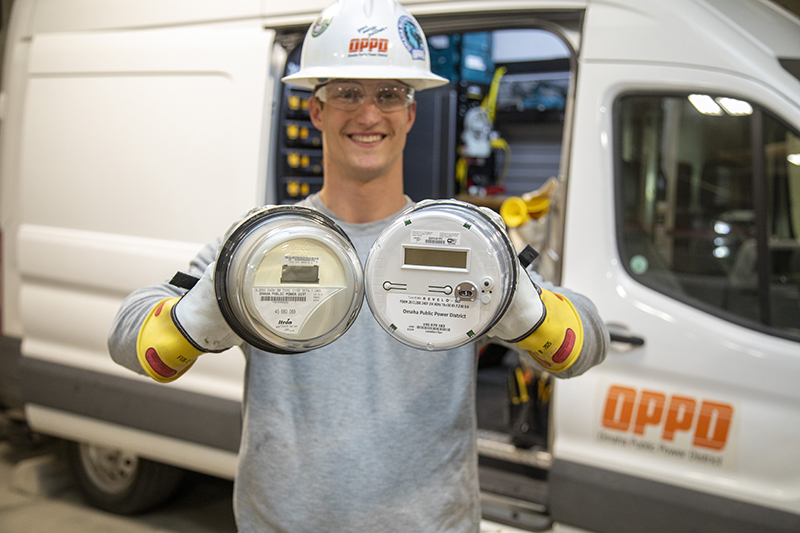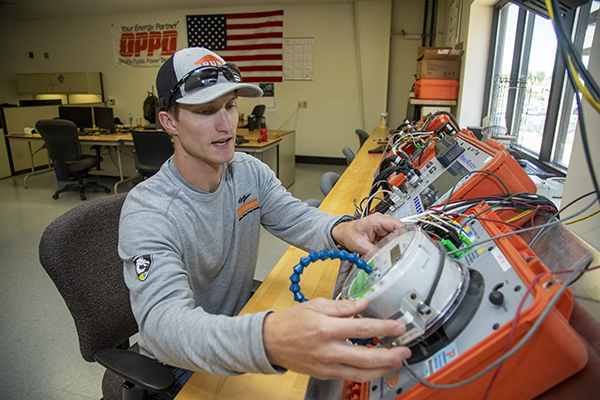What OPPD’s new smart meters will mean for you

New smart meter technology is on the way for OPPD customers, and you may have some questions.
The new meters will provide faster and more precise outage information and a modern ecosystem that will allow two-way communication between OPPD and individual customer meters.
At present, OPPD relies heavily on customer reporting to confirm outages, and granular information about the affected area isn’t always available. The new meters will offer a much more detailed picture.
“It’s going to give us a lot of new visibility into storm outages,” said Mike Iwanski, OPPD’s manager of Advanced Metering Infrastructure (AMI) transformation. “With this technology, we’ll be able to roll a truck at times before even the customer knows there’s an outage.”
By this time next year, OPPD expects to install about 10,000 customer meters in different areas (urban and rural) and with various customer types (residential, commercial, industrial).
Here’s some basic information about the new smart meters and the benefits they provide.
Safe and easy
The new meters use safe, tested technology, and OPPD is far from the first utility to adopt them. Millions of homes and businesses throughout the United States already use smart meters and have for years.
Iwanski said OPPD has learned a lot from the experiences of other utilities and incorporated those lessons into its own AMI rollout. The diversity of locations and customer types will provide important feedback that OPPD can use with the eventual rollout to all customers.
“We have a solid plan in place, and it’s exciting that we’re getting to the point where we can actually put meters on homes and businesses,” Iwanski said.

Smart meters draw their power directly from OPPD, and not customers, so the small amount of energy they use will not affect individual customer bills. Customers will still have full control of their energy usage.
The new meters communicate with OPPD via a private, encrypted network, sending only customer usage data. They have no connection to customer internet service.
The meters are also built for safety. OPPD chose new high-performance meters with excellent heat and surge resistance and accuracy.
The new smart meters also can detect and report overheating meter sockets in the rare event they occur. That will help OPPD respond and prevent any further damage. They’ll also report voltage fluctuations and failing equipment, giving OPPD time to troubleshoot and repair service problems before they cause an outage.
Same data, improved service
OPPD’s current digital meters already collect and store usage data. Mobile meter-reading technicians drive through neighborhoods with handheld equipment that remotely reads all nearby meters. The information collected allows OPPD to create an accurate bill for all customers.
The new smart meters send that same data remotely to devices strategically placed throughout OPPD’s service territory. Those devices will create a communication network for OPPD. The new meters transmit only a few minutes per day, at most. They will use a radio frequency on par with your cellphone and Wi-Fi router.
The network aggregates the data and transmits it directly to OPPD. Just like older residential meters, smart meters will collect a kilowatt-hour reading along with other electrical service values, such as current and voltage, and transmit it every four hours. That information could help OPPD with troubleshooting any issues that arise.
In the unlikely event of a house fire, smart meters can remotely disconnect power to help first responders focus safely on their job.
OPPD soon will begin contacting the first customers selected for the soft launch. OPPD will provide a 90-day advance notice before installation begins. While customers don’t need to be present during the meter exchange, the process may cause a brief power interruption.
Those customers will receive details on how to prepare for the exchange. They will also get details on the new energy tools available with their smart meter. Customers will also receive a general 30-day notice that OPPD will be arriving at their home at some point within the month.
“Smart meters are just the beginning of your energy future – one that’s more connected and built to give you greater flexibility and control,” said Missy Boldt, an OPPD business enablement lead who is helping guide the transition.

Grant Schulte joined OPPD as a content generalist in 2022. He is a former reporter for The Associated Press, where he covered the Nebraska Legislature, state politics and other news for a global audience. He is a graduate of the University of Iowa and a proud Hawkeye. In his free time he enjoys running, reading, spending time with his wife, and all things aviation.
View all posts by Grant Schulte >







